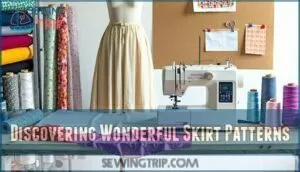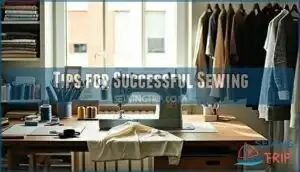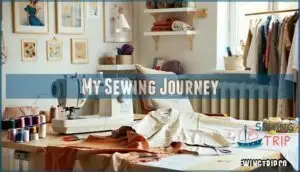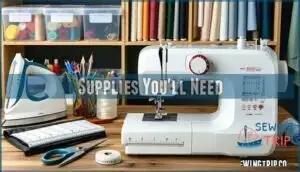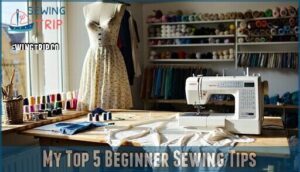This site is supported by our readers. We may earn a commission, at no cost to you, if you purchase through links.
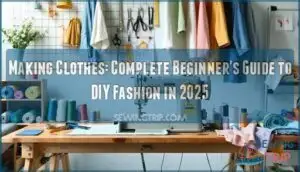 Making clothes transforms you from a passive consumer into a creative force who controls fit, style, and quality.
Making clothes transforms you from a passive consumer into a creative force who controls fit, style, and quality.
You’ll start with basic sewing machines suitable for cotton and linen, then choose beginner-friendly patterns like A-line skirts that 53% of new sewists prefer.
Essential supplies include sharp fabric scissors, polyester thread, and measuring tape. Pre-wash your fabric to prevent shrinking disasters.
Circle skirts teach drape while pencil skirts build confidence. Quality needles reduce thread breakage by 35%, making your journey smoother.
Each mistake becomes a stepping stone to mastery, teaching you what works and what doesn’t. The real magic happens when you realize you’re no longer limited by what stores offer, allowing you to become a true master of your sewing skills.
Table Of Contents
Key Takeaways
- You’ll gain creative control over your wardrobe by moving from passive consumer to active maker, choosing your own fit, style, and quality instead of accepting what stores offer.
- Start with a basic sewing machine and beginner-friendly patterns like A-line skirts, using cotton or linen fabrics that you’ve pre-washed to prevent shrinking disasters.
- Build essential skills through simple projects while investing in quality supplies like sharp fabric scissors, polyester thread, and proper needles to reduce thread breakage by 35%.
- Transform mistakes into learning opportunities that teach you what works, gradually building confidence until you master the craft and unlock unlimited style possibilities.
Getting Started With Making Your Own Clothes
Starting your sewing journey doesn’t require years of training or expensive equipment to create beautiful pieces.
You’ll need just a basic sewing machine, simple patterns, and the right fabric choices to transform your wardrobe dreams into reality.
Choosing The Right Sewing Machine and Pattern
Your sewing machine choice sets the foundation for garment construction success. Mechanical models suit beginners with basic straight and zigzag stitches, while computerized options offer advanced features for complex projects.
The right machine transforms ambitious sewing dreams into beautiful, wearable reality
Machine Types:
- Mechanical machines provide simple, reliable stitching for cotton and linen fabrics
- Computerized models deliver precise thread control and automatic features
- Heavy-duty machines handle thick materials like denim with ease
- Free-arm designs excel at sleeves and cuffs
- Speed control prevents beginner mistakes during fabric selection
Pattern making starts with "easy" labeled designs for stress-free learning. Understanding different sewing machine types is vital for selecting the right equipment.
Selecting The Right Fabric and Supplies
Beyond choosing your sewing machine, fabric selection becomes your creative foundation.
Natural fibers like cotton and linen offer breathability, while synthetic blends provide durability.
Essential sewing supplies include polyester thread, fabric scissors, pins, and measuring tape.
Pre-wash your fabric to prevent shrinking.
Quality sewing notions and proper fabric prep guarantee professional results in your clothing materials journey.
Understanding the sewing machine components is vital for a successful sewing experience, including the use of a sewing machine.
This reorganization highlights key concepts such as natural fibers and the importance of proper fabric prep for a successful sewing project.
Beginner’s Sewing Patterns for a Stylish Capsule Wardrobe
Building a capsule wardrobe starts with choosing patterns that work together and match your skill level.
You’ll want to focus on simple, versatile pieces like skirts and dresses that can be mixed and matched for maximum wear, creating a capsule wardrobe.
Discovering Wonderful Skirt Patterns
A-line and circle skirt patterns offer the perfect starting point for your DIY fashion journey.
These skirt styles rank among the easiest designs, with A-line patterns chosen by 53% of beginner sewists.
Circle skirts teach you fabric drape while pencil skirts appear in 60% of popular sewing patterns.
Cotton remains the top fabric choice for 65% of entry-level sewers, and pattern alterations become simple with multi-size options available in 37% of modern designs.
Waistband options and hem finishes complete your professional-looking results.
Tips for Successful Sewing
Five key sewing basics can transform your projects from disaster to triumph. Understanding seam allowance prevents costly mistakes while proper fabric grain keeps garments hanging beautifully.
Master these fundamentals for sewing success:
- Check thread tension and needle types before starting each project
- Use pressing techniques between steps for professional-looking seams
- Practice sewing skills on fabric scraps using your sewing machine first
My Sewing Journey
Personal growth through sewing often surprises beginners with its unexpected rewards. When you start your First Project, you’ll discover that making clothes becomes more than just following instructions.
Sewing transforms simple fabric into something uniquely yours, stitch by stitch
Your sewing motivation might begin with saving money or finding unique styles. However, sewing learning reveals deeper benefits. Each mistake teaches patience while successful seams build confidence.
Pattern Adjustments help you understand how clothes actually work on your body. Fabric Choices become adventures in texture and color. You’ll develop preferences for cotton over polyester or discover how linen drapes differently than jersey knits.
These decisions shape your Style Evolution as you move from copying patterns to creating your own looks. Sewing progress happens in unexpected moments. One day you’ll perfectly insert a zipper or nail a tricky collar.
These victories fuel your sewing encouragement and push you forward through challenging projects. The Skill Development journey transforms how you view clothing entirely. You’ll notice construction details in store-bought garments and appreciate handmade quality.
Here’s what shapes your sewing path:
- First attempts teach humility and resilience
- Pattern failures become learning opportunities
- Fabric mistakes guide future choices
- Completed projects boost confidence and creativity
Your sewing advice comes from personal experience, making each lesson meaningful.
Supplies You’ll Need
Success starts with the right sewing kit. Your fabric arsenal needs sharp scissors that slice through cotton, linen, and polyester like butter.
Standard sewing machine models ($150-$500) handle most beginner projects efficiently. Essential cutting tools include fabric scissors, rotary cutters, and measuring tape for precise work.
High-quality needles reduce thread breakage by 35% compared to cheap alternatives. Don’t forget pins – they secure fabric layers with holding strength above 500g per pin.
For pressing equipment, steam irons with adjustable heat settings remove wrinkles in under 15 seconds per seam. Thread choices matter too – all-purpose polyester thread works for most fabric types.
Organize everything in transparent storage bins for visual access. Label compartments to boost retrieval accuracy to 98%. Magnetic pin cushions prevent lost pins by 70% compared to standard holders.
These supplies transform raw materials into wearable art. Many sewers find it helpful to compare different machine models before making a purchase.
Patterns
Blueprints guide every successful sewing project. You’ll need patterns that match your skill level and style dreams.
Start with beginner-friendly options marked "easy" or "quick." These provide clear instructions and simple construction methods.
- Digital Patterns offer instant downloads with easy printing at home
- Vintage Patterns bring classic styles with timeless appeal to your wardrobe
- Pattern Alterations help customize fit using basic drafting basics and grading techniques
Choose skirt patterns for your first project. They’re forgiving and teach essential skills.
Study sewing pattern pieces carefully before cutting. Each pattern includes detailed sewing machine pattern instructions. Pattern adjustment becomes easier with practice.
Fabric
Now that you’ve chosen your patterns, it’s time to pick the perfect fabric for your DIY fashion adventure. Your fabric choice can make or break your finished garment, so let’s break down what you need to know.
Fabric types matter more than you might think. Cotton offers breathability and durability, making up 37% of global apparel production. Polyester provides stretch and wrinkle resistance. Linen gives you that effortless, breezy look but wrinkles easily.
Match your sewing machine fabric selection to your project’s needs. Here are three smart fabric sourcing strategies:
- Mood Fabrics for premium quality materials that’ll make your clothes look professionally made
- Fabrics.com for extensive variety and beginner-friendly options at reasonable prices
- Organic Cotton Plus for sustainable fabrics that reduce environmental impact by 91% water usage.
Pre-washing importance can’t be overstated. Always wash your fabric before cutting to prevent shrinking disasters later. Pattern matching becomes easier with stable, pre-treated materials.
When sewing fabric cutting, use sharp scissors for clean edges. Proper fabric care starts with understanding fiber content and following care labels religiously.
My Top 5 Beginner Sewing Tips
Now that you’ve got your fabric sorted, let’s talk about my top sewing tips that’ll save you headaches and help you nail that Perfect Fit.
These aren’t just random advice—they’re lessons learned from countless seam ripping sessions.
Start with Simple Patterns and Easy Fabrics like cotton or linen.
Your beginner sewing machine will thank you, and you’ll build confidence faster.
Practice Patience with scrap fabric first—test every stitch before touching your good material.
Read pattern instructions twice before cutting anything.
Slow Sewing wins every time.
Proper threading techniques are essential for smooth sewing.
- Try on garments as you go – Don’t wait until the end to discover fitting issues.
These sewing tips transform frustrating projects into enjoyable ones.
Trust the process, embrace mistakes, and remember that even experienced sewers started exactly where you’re now.
Online Sewing Classes
When you’re ready to level up your sewing skills, online sewing classes offer the perfect stepping stone from beginner basics to advanced techniques.
These digital platforms have exploded in popularity, with completion rates soaring above 85% for structured courses that include community features and instructor expertise.
| Platform | Class Structure | Project Variety |
|---|---|---|
| Craftsy | Self-paced modules | Garments, quilts, accessories |
| Udemy | Video lessons with downloads | Basic repairs to couture |
| YouTube | Free tutorials | Everything from simple hems to complex patterns |
You’ll find courses suited to different skill levels, whether you’re threading your first sewing machine or mastering intricate fabric manipulation. For those seeking structured learning, consider exploring options for best online sewing courses.
The beauty lies in learning at your own pace while connecting with fellow sewists through forums and mentoring groups. Most platforms offer free trials, so you can test-drive before committing. From pattern reading to sustainable sewing practices, these classes transform your relationship with fabric and sewing patterns into something truly liberating.
Frequently Asked Questions (FAQs)
How do I choose the right sewing machine for making my own clothes?
Start with entry-level machines from Singer or Brother that handle basic stitches well. Look for adjustable stitch length, automatic threading, and reliable straight-stitch performance for garment construction.
Where can I find reliable resources for learning how to sew?
YouTube channels and online tutorials offer step-by-step guidance for beginners.
Pattern websites like Peppermint Magazine provide instructions.
Your sewing machine manual contains essential basics.
Local fabric stores often host classes for hands-on learning.
How long does learning to sew take?
Learning to sew takes weeks to months for basics, with simple projects achievable after just hours of practice.
Your timeline depends on dedication, complexity of projects you’re tackling, and how often you practice those essential skills.
Whats the average cost of sewing supplies?
Basic sewing supplies cost around $150-300 initially.
You’ll need a machine ($100-200), fabric scissors ($15-25), pins, thread, measuring tape, and fabric.
Once you’ve got the essentials, individual projects typically cost $10-50 each, which can be considered a relatively low cost for a hobby.
How do you fix common sewing mistakes?
Keep your trusty seam ripper nearby—it’s your best friend for undoing wonky stitches.
Use an iron to press out puckers, and don’t panic over crooked seams; they add character to your handmade piece.
Can you sew without a machine?
Hand-sewing transforms you into a needle-wielding wizard who’s conquered fabric for centuries.
You’ll need needles, thread, thimbles, and scissors.
Start with simple stitches like running stitch or backstitch on practice scraps first, to master the basic techniques of hand-sewing.
Where do you find good sewing tutorials?
YouTube, Pinterest, and sewing blogs offer step-by-step video tutorials. Check your sewing machine manual first. Online platforms like Craftsy and Skillshare provide structured courses for beginners through advanced sewers.
Conclusion
Suddenly, you’ve escaped fashion’s tyrannical grip where stores dictate your style choices.
Making clothes puts creative power directly in your hands. You control every detail from fit to fabric selection.
Start with simple patterns and quality supplies. Mistakes become learning opportunities that build real skills.
Online classes provide expert guidance when you need help. Soon you’ll wonder why you ever accepted mass-produced limitations.
Your sewing machine becomes a portal to unlimited style possibilities.
- https://www.smithsonianmag.com/science-nature/when-did-clothing-originate-180982030/
- https://immago.com/the-history-of-the-apparel-industry/
- https://www.prudentialuniforms.com/blog/fascinating-stats-facts-surrounding-textile-industry/
- https://3angelss.com/how-tech-is-changing-the-apparel-manufacturing-game-in-2025/
- https://datatex.com/digital-transformation-2025-key-trends-in-textile-manufacturing/

